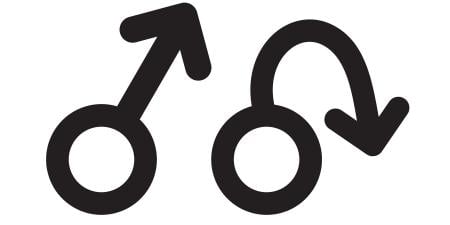Sexuality is tricky territory—for individuals, couples, society—and for professionals. Some aspects are harmful, criminal, and stigmatized, while others are central to identity, deeply pleasurable, and bonding. That’s quite a range. It’s hard to make that argument for any other topic in medicine, and it predicts some unusual complexities in dealing with sexual complaints.
Physicians listen to people who come with complaints to office or clinic. They help people think more clearly about their complaints by exploring their origins, details, and possible resolutions through history taking, physical exam, and laboratory testing. Something hurts. Something isn’t functioning properly.
When it comes to sexuality, tricky elements enter the picture. Despite the avalanche of sexual subjects in the media, when it comes to a one-on-one conversation with a doctor, most patients are tongue-tied and embarrassed about their complaints (“I don’t know what’s the matter”), and many use mysterious euphemisms (“Doc, my nature isn’t right”). People who might actually be bold in bed can feel paralyzed when trying to speak about their sexual habits or problems. Shame and self-consciousness often result in misleading descriptions (saying “I can’t perform” when it would be more accurate to say “I can’t perform with my new girlfriend although I can perform quite well with my wife”). Because sexuality is so private, most people have unanswered questions about their own experience and let these questions persist, unanswered, for decades until finally they get to an “expert.”
Because sexuality is so politically controversial, most people receive little formal education and remain astonishingly ignorant about sexual anatomy and physiology. Don’t be surprised when they call everything between the navel and the knee “the vagina” or “private parts” or “lady bits” and consistently use vague, imprecise, or inaccurate language. Don’t be surprised when patients appear to be amazed by seemingly commonsense information—for example, that factors like health, alcohol, sleep, and worries can affect sexual interest, function, and experience. Sexologists learn early never to overestimate the public’s knowledge base about sex.
Above all, people often disguise their problems by asking the doctor factual-ish questions that begin, “Is it normal…?” “Doc, is it normal to masturbate after you are married, to look at Internet porn at 3 in the morning, to ejaculate during foreplay, to like to wear girlie underwear during sex, to hate oral sex, to want only oral sex, to cry after orgasm, to lose interest in sex after the first baby,” and on and on and on. How should the doctor handle such inquiries and what are the resources to consult? (Please, don’t say “the Internet.”) Is the doctor really supposed to be an expert on all of this? Are there sexual complaints that physicians are not equipped to address or details they shouldn’t delve into? And, in that case, where should people go for help?
Unfortunately, doctors are expected to have skills and knowledge in the area of sexuality despite very little formal training. (Note to reader: Please agitate in your school for better and more comprehensive sex ed. And please ask that the instructors be really knowledgeable.) Back in the 1970s, when I began teaching medical and nursing students, many schools scheduled a “sex week” in the second year, when, in addition to faculty and guest lectures, students were assigned diverse readings and saw films depicting many forms of sexual expression. This was pre-Internet and even prevideotapes, so few students had seen erotic activity on film before. There would also be many small group discussions examining the sexual attitudes and values students brought from their own cultural and religious backgrounds. Exploring “sexual myths” was emphasized, since limited knowledge combined with strong opinions seems to produce enduring myths, for both patients and professionals. “Sex week” has gone by the boards for many reasons and it’s a shame. The American Medical Student Association (AMSA) has tried to fill the breach with an excellent online course [1].
These values clarification exercises are important precisely because patients’ “is it normal?” questions are not requests for factual or scientific answers but are more or less transparent requests for moral authority. If physicians aren’t self-aware and broadly informed, their answers to these questions could well be projections of their own values. A question like “Is it normal to masturbate after you are married?” sounds like a request for advice based on scientific evidence, but think again. What type of epidemiology would provide sound evidence on that question? What sample drawn from what population? What (cultural, religious, ethnic, regional) assumptions about marriage lie behind the question—and how is a physician supposed to know the patient’s expectations about appropriate marital behavior?
Furthermore, what definition of “normal” is implied in the question? In a 1986 essay called “Am I Normal? The Question of Sex,” I wrote about five different definitions that apply to sexuality: subjective, statistical, idealistic, cultural, and clinical [2]. Most often, patients want some hybrid scientific-moral answer that they can use to defend their own behavior to themselves or their partners (“The doctor said it’s normal for desire to decrease after a few years of marriage, so leave me alone”). The more experience the medical student acquires with subtly answering these questions (“Some people continue masturbating after marriage, others don’t. Tell me why you are asking”), the better able he or she will be to explore the particular concerns of each patient without closing off conversation with hasty and superficial science-y generalizations (“Well, of course, when hormones drop after menopause many women lose interest in sex”).
Another reason why small group discussions centering on values clarification are so important is that research (then and now) shows that medical students by and large do not have wide sexual experience and often tend towards conservative values [3, 4]. Maybe they studied too much biochemistry and not enough anthropology in college or maybe they had fewer sexual experiences because of cramming for the MCATs. In any case, people with limited experience and unexplored values are not well prepared to answer urgent and anxious sexual questions, alas.
Although it is difficult to find resources that will specify what is sexually normal (“How hard is hard?” “How wet is wet?”) or that discuss the many challenges involved with defining sexual normalcy, there is no shortage of resources that list sexual disorders and abnormalities. As a consequence, without even thinking about the complexities involved in drawing these lines of demarcation, medical students may simply learn that if something isn’t classified as a disorder, it’s likely to be normal. Ouch! That is a simple answer to a complex question, and it’s good to remember journalist H. L. Mencken’s saying, “There is always an easy solution to every human problem—neat, plausible, and wrong” [5].
Nowadays the lines between healthy and deviant sex are globally dictated by the American Psychiatric Association’s Diagnostic and Statistical Manual of Mental Disorders (DSM), a huge tome now in its fifth edition [6]. There are many places to learn the fascinating history of the DSM—I recommend an extremely readable New Yorker magazine profile that is available online [7]. It deals mostly with the revolution in psychodiagnostics represented by the DSM-III (in 1980), and it doesn’t even mention sexuality nomenclature (except for the APA members’ vote to declassify homosexuality in 1973—yes, they took a vote, which tells you in a nutshell how difficult it is to be scientific about sexual norms), but nonetheless this profile will give you some idea of the many issues and controversies in psychodiagnostics.
It’s hard to understand exactly how it is that the American Psychiatric Association became the global arbiter of sexual norms—we’ll have to wait for the history books on that—but the short answer is that they moved into a vacuum. As society was liberalizing, doctors became more interested in sexual topics, and, furthermore, conducting the changing business of medicine in the insurance era required a list of conditions for which consultation and treatment would be reimbursed. The DSM-III was developed at the moment when classification moved from being an adjunct to medicine and research to being a necessity for a new institutional world of bureaucratic economic arrangements. These trends have only continued in the subsequent 35 years. Some sort of nomenclature was needed—and nomenclature was found.
There are currently three main categories of sexual disorders listed in the DSM: gender dysphoria, paraphilic disorders, and sexual dysfunctions. The chances are that the first two categories of disorders will never come up outside a psychiatric practice (well, maybe endocrinologists and plastic surgeons are getting more involved with transgender patients), but, in the absence of any “sex week” educational exposure, it is important for every physician to know that erotic pleasures occur in more diverse situations than you can imagine and that gender identity is a very complicated idea, so it would be good to read through those sections in the DSM online [8-10].
The subject of sexual dysfunctions will be more relevant for every physician. The history of the specific diagnoses in these categories in DSM-III and IV is long and complex and includes the views of some who criticize the origins of the very category itself [2]. What, after all, is “sexual function”? If that can’t be defined—and many have tried and failed—how do we define “sexual dysfunction”? The DSM-5 has attempted to dispense with all theory and just list, alphabetically, ten disorders and their specific diagnostic criteria. This seems rather arbitrary, on the one hand (why these ten?), but at least it removes criticisms of the weak theoretical background, on the other.
It may seem overly easy to apply these ten diagnoses, but understanding how to use them in a clinical context takes practice. For example, hearing that a man is complaining about ejaculating quickly during intercourse, the clinician looks up “premature ejaculation,” and sees that the major criteria are “ejaculating within 1 minute following vaginal penetration” on at least 75 percent of occasions, for at least 6 months, being distressed about it, and not having a severe relationship or stress problem. If the one-minute rule seems arbitrary (and it does to me, since men from the Caribbean have different standards for the appropriate duration of intercourse than men from Europe, as I learned through working with hundreds of men in a Bronx, New York, hospital-based urology department), it might be worthwhile to take a look at the cultural issues section in the DSM-5introduction: “The boundaries between normality and pathology vary across cultures for specific types of behaviors. Thresholds of tolerance for specific symptoms or behaviors differ across cultures, social settings, and families” [11]. While I think this was intended more for psychopathological symptoms, it applies very well to symptoms of sexual dysfunction.
The physician has a great deal of influence in the consulting room when it comes to the anxious and poorly informed patient with a sexual complaint. Don’t rush to label distress a sign of a disorder. It might lead to needless stigmatization and misdirection of intervention [12]. Ask a lot of questions and answer them briefly. Sexual dysfunctions are often adaptive solutions within relationships (“I’m sorry, honey, I can’t” rather than “I don’t want to”), which is tricky to diagnose and trickier to treat. Did Tiger Woods have a sexual addiction (fortunately not listed in the DSM-5, though there are various other tantalizing possibilities in the paraphilic disorders section), or was he just exhibiting arrogance, self-indulgence, and bad judgment influenced by celebrity status and easy access? Or all of the above? It’s tricky.
References
-
American Medical Student Association. Sexual health leadership course: an online learning community and course, fall 2014-spring 2015. http://www.amsa.org/AMSA/Homepage/EducationCareerDevelopment/AMSAAcademy/SHLC.aspx. Accessed September 11, 2014.
-
Tiefer L. Sex is Not a Natural Act and Other Essays. 2nd ed. Boulder, CO: Westview Press/Perseus Books; 2004.
- Shindel AW, Ando KA, Nelson CJ, Breyer BN, Lue TF, Smith JF. Medical student sexuality: how sexual experience and sexuality training impact US and Canadian medical students’ comfort in dealing with patients’ sexuality in clinical practice. Acad Med. 2010;85(8):1321-1330.
- McKelvey RS, Webb JA, Baldassar LV, Robinson SM, Riley G. Sex knowledge and sexual attitudes among medical and nursing students. Aust N Z J Psychiatry. 1999;33(2):260-266.
-
Mencken HL. The divine afflatus. A Mencken Chrestomathy. New York: Knopf; 1949:443.
-
American Psychiatric Association. Diagnostic and Statistical Manual of Mental Disorders. 5th ed. Arlington, VA: American Psychiatric Publishing; 2013. http://dsm.psychiatryonline.org. Accessed September 4, 2014.
-
Spiegel A. The dictionary of disorder: how one man revolutionized psychiatry. New Yorker. January 3, 2005. http://www.newyorker.com/magazine/2005/01/03/the-dictionary-of-disorder. Accessed September 10, 2014.
-
American Psychiatric Association. DSM library: gender dysphoria. http://dsm.psychiatryonline.org/content.aspx?bookid=556§ionid=41101780. Accessed September 12, 2014.
-
American Psychiatric Association. DSM library: paraphilic disorders. http://dsm.psychiatryonline.org/content.aspx?bookid=556§ionid=41101785. Accessed September 12, 2014.
-
American Psychiatric Association. DSM library: sexual dysfunctions. http://dsm.psychiatryonline.org/content.aspx?bookid=556§ionid=41101779. Accessed September 4, 2014.
-
DSM-5, 14.
- Wakefield JC. The DSM-5’s proposed new categories of sexual disorder: the problem of false positives in sexual diagnosis. Clin Soc Work J. 2012;40(2):213-223.



